-
Developing materials for more resilient concrete pavements
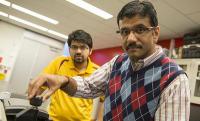
Aging roadways pose a growing threat to transportation infrastructure which is critical to the health of economies throughout the world. Beyond the daunting task of funding extensive restoration efforts, there is an equally pressing challenge to find ways to rebuild major roads which are more sustainable. Researchers have been experimenting with what are called phase-change materials to produce more resilient concrete surfaces for roads and bridges. Phase-change materials are substances which respond to temperature variations by changing their state from solid to liquid or vice versa, and can be sourced from petroleum (such as paraffin wax) or be plant-based. A new project is exploring the use of a phase-change material solution for reducing or preventing temperature-related cracks in concrete pavement.
-
-
Self-compacting concrete is now fire resistant as well
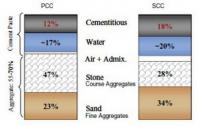
Self-compacting high-performance concrete (SCHPC) has till now suffered from one weakness — when exposed to fire it flakes and splits, which reduces the loadbearing capacity of ceilings, walls, and supporting pillars, thus increasing the risk of collapse in a burning building. Scientists have now developed a method of manufacturing fire resistant self-compacting high-performance concrete which maintains its mechanical integrity under these conditions.
-
-
U.S. reliance on nonfuel mineral imports increasing
Key nonfuel mineral commodities that support the U.S. economy and national security are increasingly being sourced from outside the U.S., according to a new U.S. Geological Survey report. Over the past sixty years, there has been an increase in the number and diversity of nonfuel commodities that the United States imports as well as the extent to which the United States is import reliant.
-
-
Recovering rare earth elements from coal mining waste
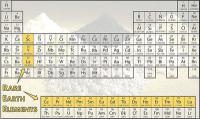
West Virginia could become one of the country’s significant sources for rare earth elements (REE), the “vitamins of modern industry,” without the expense or environmental cost of opening new mines. A new project brings together academia, state regulators, and industry to collaborate on finding a successful recovery technology for total REEs from acid mine drainage, or AMD. In Pennsylvania and West Virginia alone, it is estimated that AMD generates more than 45,000 tons of total REEs per year or about three times the current U.S. demand for total REEs.
-
-
Fibers from natural fats make bulletproof vests stronger and greener
Bulletproof vests and other super-strong materials could soon become even tougher and more environmentally friendly at the same time with the help of extra firm, or “al dente,” fibers. These materials, which are powerful enough to stop speeding bullets, can also be used for many other tasks that require strength.
-
-
U Maine launches center for studying, developing coastal and offshore structures
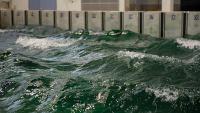
During a laboratory dedication on Monday at the University of Maine, the Harold Alfond Foundation announced a $3.9 million grant to the University of Maine to match $9.98 million already raised, formally establishing the Harold Alfond W2 Ocean Engineering Laboratory and Advanced Manufacturing Laboratory at the Advanced Structures and Composites Center on campus. The UMaine Composites Center is the largest STEM research and development program located in a Maine university, and is at the heart of one of UMaine’s seven Signature Areas of Excellence — Advanced Materials for Infrastructure and Energy.
-
-
Solving the problem of “concrete disease”
When bridges, dam walls, and other structures made of concrete are streaked with dark cracks after a few decades, the culprit is AAR: the alkali-aggregate reaction. Also called the “concrete disease,” or even “concrete cancer,” it is a chemical reaction between substances contained in the material and moisture seeping in from outside. AAR damages concrete structures all over the world and makes complex renovations or reconstructions necessary. Researchers have now solved the structure of the material produced in the course of AAR at atomic level — and have thereby discovered a previously unknown crystalline arrangement of the atoms.
-
-
Self-healing concrete being tested
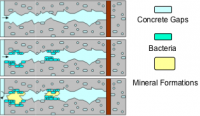
At present, billions of pounds are spent every year maintaining, fixing, and restoring structures such as bridges, buildings, tunnels, and roads. It is estimated that around £40 billion a year is spent in the United Kingdom on the repair and maintenance of structures, the majority of which are made from concrete. Researchers are testing three separate concrete-healing technologies for the first time in real-world settings, with a view to incorporating them into a single system that could be used to automatically repair concrete in the built environment.
-
-
Recovering rare earth materials from electric and hybrid vehicle motors
China currently supplies about 97 percent of rare earth materials used in manufacturing around the world. In an effort to help develop a sustainable domestic supply of rare earth elements and lessen the U.S. dependence on China for materials that are vital to the production of electronics, wind turbines, and many other technologies, researchers have developed a method of extracting rare earths from the drive units and motors of discarded electric and hybrid cars.
-
-
DOE’s rare-earth recycling invention commercially licensed
The Department of Energy’s Critical Materials Institute (CMI) seeks ways to eliminate and reduce reliance on rare-earth metals and other materials critical to the success of high-tech industries. A new technology developed by CMI aids in the recycling, recovery, and extraction of rare earth minerals. It has been licensed to U.S. Rare Earths, Inc. The membrane solvent extraction system is the first commercially licensed technology developed through the CMI.
-
-
Green concrete is more fire-resistant
Selecting materials with high fire endurance is particularly important when constructing tunnels and high-rise buildings, and when storing hazardous materials. Concrete made using an industrial by-product has shown better fire endurance than traditional concrete when exposed to fires of nearly 1,000 degrees Celsius.
-
-
Simplifying recycling of rare-earth magnets
Despite their ubiquity in consumer electronics, rare-earth metals are, as their name suggests, hard to come by. Mining and purifying them is an expensive, labor-intensive and ecologically devastating process. Researchers have now pioneered a process that could enable the efficient recycling of two of these metals, neodymium and dysprosium. These elements comprise the small, powerful magnets that are found in many high-tech devices. In contrast to the massive and energy-intensive industrial process currently used to separate rare earths, the new method works nearly instantaneously at room temperature and uses standard laboratory equipment. Sourcing neodymium and dysprosium from used electronics rather than the ground would increase their supply at a fraction of the financial, human and environment cost.
-
-
Rebuilding a safer and stronger Vanuatu after Cyclone Pam
Three months ago Cyclone Pam swept across Vanuatu, leaving 75,000 people in need of emergency shelter and damaging or destroying about 15,000 buildings, including homes, schools, and medical facilities. Since then, one of the most hotly debated questions within communities and on social media has been about how Vanuatu can rebuild so that it’s safer, stronger, and more resilient to future cyclones. Achieving this is not as simple as you might think. The strength and safety of buildings is critical — especially when you are rebuilding in a cyclone-prone region. But housing in particular is about more than walls and roofs; it’s also about community, traditions, culture, and supporting the way people want to live. While the strength of buildings and their ability to withstand cyclones are very important, so too are the strength and resilience of the people of Vanuatu, who have been living with the annual cyclone season for generations. The reconstruction of Vanuatu needs a diverse approach that is not solely reliant on quickly prefabricated or engineered solutions, and which keeps people at the heart of the rebuilding process.
-
-
Giant foam blocks keep approach slabs of bridges from settling
The majority of the world’s largest cities, often built in areas near water bodies, have soft and compressible soils. For example, a good number of the 52,000 bridges in Texas have bump problems on entry due to settling of the soil under the pavement slabs. A research team at the University of Texas at Arlington (UTA) is using giant lightweight geofoam blocks to bolster the earth beneath roads and bridges and slow down the settling of roadways and bridges.
-
-
Using UV light to separate rare earth metals
Europium and yttrium are two rare earth metals that are commonly used in sustainable technology and high-tech applications. As these rare earth metals are difficult to mine, there is a great interest in recycling them. Researchers have discovered a method to separate europium and yttrium with UV light instead of with traditional solvents. Their findings offer new opportunities for the recycling of fluorescent lamps and low-energy light bulbs.
-
- All
- Regional
- Water
- Biometrics
- Borders/Immig
- Business
- Cybersecurity
- Detection
- Disasters
- Government
- Infrastructure
- International
- Public health
- Public Safety
- Communication interoperabillity
- Emergency services
- Emergency medical services
- Fire
- First response
- IEDs
- Law Enforcement
- Law Enforcement Technology
- Military technology
- Nonlethal weapons
- Nuclear weapons
- Personal protection equipment
- Police
- Notification /alert systems
- Situational awareness
- Weapons systems
- Sci-Tech
- Sector Reports
- Surveillance
- Transportation
Advertising & Marketing: advertise@newswirepubs.com
Editorial: editor@newswirepubs.com
General: info@newswirepubs.com
2010-2011 © News Wire Publications, LLC News Wire Publications, LLC
220 Old Country Road | Suite 200 | Mineola | New York | 11501
Permissions and Policies
Editorial: editor@newswirepubs.com
General: info@newswirepubs.com
2010-2011 © News Wire Publications, LLC News Wire Publications, LLC
220 Old Country Road | Suite 200 | Mineola | New York | 11501
Permissions and Policies
